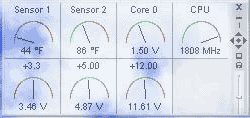Peltier Condensation Prevention
Article by Jason on 09.09.2003
Results:

Peltier Condensation Prevention
Article by Jason on 09.09.2003
Results:
| The system was completely stable upon first startup after the modification. I can truly say that I was apprehensive about any condensation forming and checked the now visible cold plate each 2 minutes for any sight of condensation. I can also say that the system stayed on for 6 hours after that first start until I shut it down for the night, and at shutdown there was still no sign of condensation forming. |
| The results speak for themselves. One week after this modification and still no condensation, my temperatures at 43F are well below ambient. These temps are also below what I was able to achieve previously with the identical hardware using closed cell foam. |
| New Temps with the Acrylic Container: | Previous Temps with the Installation and Foam: |
| Idle: 44F | Idle: 48F |
| Load: 51F | Load: 56F |
Conclusion:
I believe this modification shows a valid alternative for some overclockers.
I will personally be sticking with this mod and working on some ways to improve
it. There is the case modder side of me that is screaming to get some UV reactive
acrylic and use it to create another cube and replace the clear one, or use
LED's countersunk into the acrylic. The possiblities are near endless.
 |
Possible improvements in design would include:
** Discuss this article with Jason and other readers in our forums! **
| « Back a Page | More Articles » |